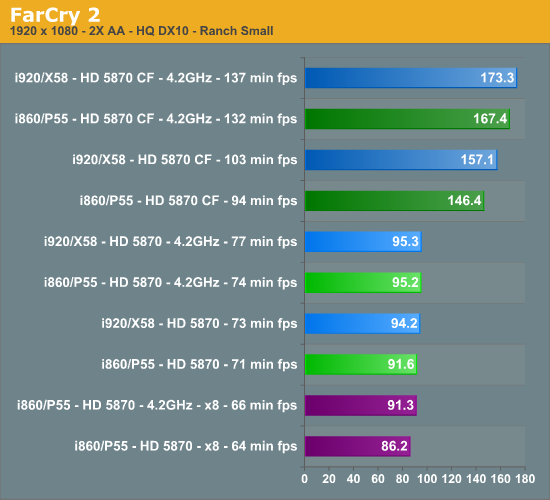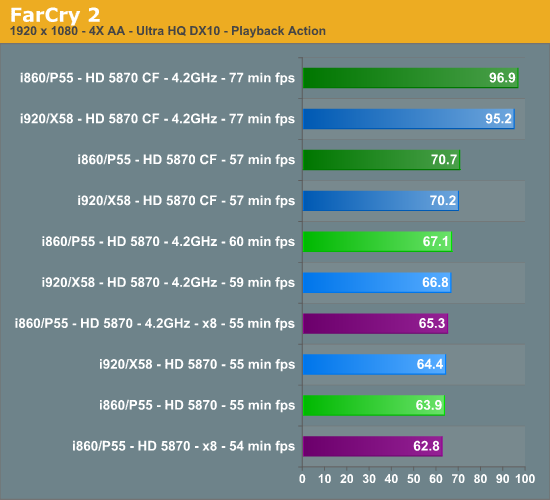ATI HD 5870 Scaling Performance: X58 vs P55 Showdown
by Gary Key on September 29, 2009 12:00 PM EST- Posted in
- Motherboards
FarCry 2
We utilize the Ranch Small demo file along with the Playback Action demo to see the differences between GPU and CPU centric benchmarks. The Ranch demo is GPU centric while the Playback demo tends to be CPU centric. We run each benchmark five times and report the median score.

First off, FarCry 2 has always performed extremely well on the X58 chipset compared to other chipsets with the ATI video cards. This game responds very well to PCIe bandwidth, something the X58 has in droves. The stock HD 5870 single card x8 configuration is 6% slower in average frame rates and 10% slower in minimum frame rates in this particular benchmark. Even the 4.2GHz single card result is slower than either the stock P55 or X58 setups.
The stock single card HD 5870 P55 platform is 3% slower than the X58 even with a 100MHz processor advantage in turbo mode. At 4.2GHz, both platforms are about even although minimum frame rates are about 4% better on X58. However, even with this benchmark advantage, there was no difference in actual game play, especially considering minimum frame rates are above 70fps in each instance.

The P55 results improve slightly as we move to a more CPU centric benchmark. The stock HD 5870 single card x8 configuration is only 2% slower in average frame rates and only 1% in the overclocked results. Comparing single card results between the P55 and X58, we see a 2% difference in favor of the X58 at stock speeds while at 4.2GHz the P55 finishes slightly ahead of the X58.
The pertinent data for CrossFire scaling is in the tables below. What we are looking for is the percentage speedup going from one to two HD 5870s on X58 and P55. In theory, X58 should have improved percentages because each GPU gets 16 PCIe 2.0 lanes while Lynnfield only provides 8 PCIe 2.0 lanes per GPU.
FarCry 2 CrossFire Scaling – Average Frame Rates
| ATI HD 5870 CF Scaling | FarCry 2 – Ranch Small | FarCry 2 – Playback Action | FarCry 2 – Ranch Small 4.2GHz | FarCry 2 – Playback 4.2GHz |
| Intel Core i7 920 (X58) | 66.8% | 9% | 81.8% | 42.5% |
| Intel Core i7 860 (P55) | 59.8% | 10.6% | 75.8% | 44.4% |
Based on our single card results, there are not a lot of surprises here. At stock speeds, the X58 has a 7% scaling advantage over the P55 and 6% when overclocked in the GPU centric Ranch demo. In the Playback Action benchmark, the results favor the P55 by almost 2%.
FarCry 2 CrossFire Scaling – Minimum Frame Rates
| ATI HD 5870 CF Scaling | FarCry 2 – Ranch Small | FarCry 2 – Playback Action | FarCry 2 – Ranch Small 4.2GHz | FarCry 2 – Playback 4.2GHz |
| Intel Core i7 920 (X58) | 41.1% | 3.6% | 77.9% | 30.5% |
| Intel Core i7 860 (P55) | 32.4% | 3.6% | 78.4% | 28.3% |
Minimum frame rates and scaling heavily favor the X58 in our stock clock speed results using the Ranch demo. Although frame rates still favor the X58 in this demo when overclocked, the scaling on the P55 is slightly better. The stock results in the Playback Action demo are a dead heat with a 2% advantage to the X58 when overclocked.
When it came to actual game play, there were no differences between either platform in the game. In fact, it was very difficult to discern which system was being utilized. The key giveaway was the foot warming heat coming from our case with the X58 overclocked. Our ambient temperature in the test room rose 2.1C over the course of testing with the X58 installed compared to 0.7C with the P55.










85 Comments
View All Comments
TurdMiner - Wednesday, September 30, 2009 - link
TA152H "Wow, I'm being patronized by someone with half my IQ. And not even well. That's actually the worst attitude. That patronizing attitude like you're superior...How hypocritical."That's hella funny.
You meant that to be funny, right?
tim851 - Wednesday, September 30, 2009 - link
I don't think he gets it.TimboG - Tuesday, September 29, 2009 - link
I agree with you that they should NEVER alter ANY processor or motherboard speed settings during a platform performance comparison benchmark.How in the world can you publish a "comparison" between two platforms when the chipsets themselves have been altered from their stock setting? This is nuts.
I read but keep quiet on most everything AnandTech publishes but this one takes the cake. To call itself a comparison of platforms where each has been altered is one article headed for file 13. I have noticed several of the "professional" review websites doing this in the past year or so and I for one think this type of comparison should be discontinued altogether. If you want to test overclocking ability then do it in a separate article. If you want to compare overclocked performance between multiple platforms then do it as such. Not as a direct performance comparison between platforms where each has been altered.
You guys with your little plaques hanging on your walls and the cute name tags on your shirts are driving me mad while trying to get straight answers to simple questions.
How about some real-time direct comparisons to what has been produced instead of what you want to "play" with in the BIOS before you benchmark? I don't care if TURBO is on if it is part of the "normal" operation of the combined CPU/motherbaord combo. At least that way it will show what you can expect "out of the box".
Intel has continually been degrading our options as this last development cycle has progressed with less CPU options per platform and slowly removing functionality from others.
It's almost like going to an auto dealer and getting the "confusion sell" tactic push onto us.
I could go on forever. No USB3, no SATA6 ? At least there should have been some news during IDF to present new chipsets that supported these features, but nothing. It's almost laughable, but sad actually.
Then we get manipulated platforms portrayed as being compared directly against each other and the results are something we should use to make a purchase decision with? Then combine that with the confusion sell Intel is already pushing on us. This is NUTS!
goinginstyle - Tuesday, September 29, 2009 - link
"I agree with you that they should NEVER alter ANY processor or motherboard speed settings during a platform performance comparison benchmark."Dude, nothing was altered as they kept the systems at stock values/settings and ensured the memory timings were the same between platforms. How fair can you get and by the way they were open about everything. It is a sad state of affairs when being honest in an article gets you slammed.
Jumpem - Tuesday, September 29, 2009 - link
In the original P55 review, and follow up i7 860 review, the i7 860 delivered higher framerates than the i7 920 at stock speeds.In this write up the i7 920 is coming out on top at stock speeds. I'm slightly confused. Gary, do you care to comment?
Gary Key - Tuesday, September 29, 2009 - link
We were using the NVIDIA (275/285) cards in those reviews. ;) I have a meeting with AMD in the morning to further discuss our results. They have been working with our test results since this weekend to pinpoint why the HD 5870 is generating different results than the NV cards and even the HD 4890.turnipoid - Tuesday, September 29, 2009 - link
I really don't see the point of this article if it doesn't include 2560 X 1600.xrror - Wednesday, September 30, 2009 - link
Probably because if you can afford a 2560x1600 monitor you already have an x58 in preparation for i9.the zorro - Wednesday, September 30, 2009 - link
at that resolutions the lynnfield bottleneck becomes more evident.so it's better not to include that resolution.
the zorro - Tuesday, September 29, 2009 - link
wow, Battle Forge CrossFire Scaling – Minimum Frame Rates difference is huge.this show how crippled the lynnfield platform is.
almost 100% percent difference between lynnfield and x58
this sucks.
what's wrong with intel?